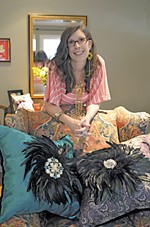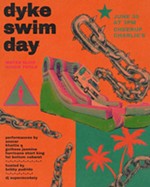Gowns by Adrian
A tribute to Gowns by Adrian
Reviewed by Stephen MacMillan Moser, Fri., June 29, 2001

GOWNS BY ADRIAN
Adrian was the queen of all Hollywood costume designers. When you imagine the inimitable, over-the-top glamour of Crawford, Garbo, or Harlow, they are likely to be wearing an Adrian gown. "Gowns by Adrian" is a credit that appears in some form or another in well over 230 films, and through those films, his influence on fashion was heard around the world. (Personally, if a film doesn't have a "gowns" credit, I won't watch it.)
Born in 1903, under the name Adrian Adolph Greenberg, he trained at New York's prestigious New York School of Fine and Applied Arts (now Parsons), and studied briefly in Paris, where he led a rather flamboyant existence and hung out with Erté and his ilk. Irving Berlin discovered him there and took Greenberg back to New York, where Berlin gave him a job designing for the Broadway hit Music Box Review in 1923. Quickly decamping for Hollywood, he changed his name to the much more exotic Adrian (an obvious influence of Erté), and was hired by Natacha Rambova. Replacing previous designer Norman Norell, he was to help revive the rapidly disintegrating career of her then-husband, Rudolph Valentino. It didn't work -- Adrian's first two films were Valentino's last. Adrian was then hired as production designer for the formidable Cecil B. DeMille from 1926-28. Subsequently, he was hired as the chief costume designer for MGM, where he became an asset as important as any star. His designs were characterized by bold silhouettes and patterns, dolman and kimono sleeves, long tapering waistlines, and diagonal fastenings. He favored asymmetric lines and frequently used black crepe for slim, bias-cut evening gowns.
At MGM, Adrian was in hog heaven. Dressing Joan Crawford for no fewer than 28 film roles, including Humoresque, Possessed, A Woman's Face, The Bride Wore Red, and Ice Follies of 1939, Adrian's influence was epitomized by the wide-shouldered white organdy dress for Letty Lynton. This little frock was widely copied by manufacturers throughout the country; Macy's reportedly sold a half million. Adrian gave Crawford her visual hallmark: wide, padded shoulders that made her hips look smaller. Though thickly padded shoulders had already been introduced by Schiaparelli, Crawford graciously noted later that her reputation as a fashion trendsetter was the by-product of Adrian's genius. The Women, an all-star, all-female cast proved to be a playground for Adrian's talent. Dressing the star-studded cast, which included Crawford, Norma Shearer, Rosalind Russell, Paulette Goddard, and Joan Fontaine, presented Adrian with a smorgasbord of characters to clothe, from a scheming shop girl to a fashion victim to a society matron. The Technicolor fashion show sequence is simply amazing. Adrian turns out ensemble after ensemble, some including the trend toward surrealism, but all are fantasy creations that became part and parcel of the Hollywood "look."
Adrian's 18 films with Norma Shearer, including The Barretts of Wimpole Street, Marie Antoinette, Private Lives, and Idiot's Delight, had fabulous clothing and accessories. Though grossly miscast, the little beaded Juliet cap that Shearer wore in Romeo and Juliet became the rage among stylish women. He did nine films with Jean Harlow, including Dinner at Eight, Bombshell, and Red-Headed Woman. He produced slinky, sexy, figure-hugging dresses, cut on the bias, such as the magnificent satin gown with the open sleeves for China Seas. Adrian did three films for Katherine Hepburn, including The Philadelphia Story and Woman of the Year, searing her sporty-yet-glamorous image into our consciousness. For Judy Garland, he designed the costumes for, among others, The Wizard of Oz, including the iconic ruby slippers. Adrian never tried to recreate actual historic period clothes, but used the silhouettes as a springboard to create his original designs.
Adrian dressed Greta Garbo for virtually her entire career, including the incredible creations for Mata Hari, Grand Hotel, and Anna Christie. His creations for Anna Karenina were dazzling, grand and frothy confections, as were his designs for Camille (which is considered to be an entirely gay film, because every actor and actress involved, as well as the director and all the designers, were rumored to be gay). In 1928, he designed the androgynous slouch hat for Garbo's Woman of Affairs -- setting a trend that lasted through the Great Depression. The lavish velvets and sexually ambiguous stylings for Queen Christina, in which Garbo utters the words, "I shall die a bachelor," were a sensation. He also made waves with the Empress Eugenie hat, alluringly tilted over the eye, and was widely copied for that. In fact, it was his work with Garbo that eventually ended his tenure at MGM. In 1941, Adrian had an argument concerning the studio's intention to deglamourize Garbo for Two-Faced Woman. Sniffed the queen of designers, "When glamour is over for Garbo, it is over for me," and he flounced off in a snit, never to return. The queen meant business.
In 1939, Adrian married the charming actress Janet Gaynor, who had won the very first Best Actress award for her work in Sunrise and Seventh Heaven in 1927. They produced a son, Robin, but it was widely speculated to be a "bearded" marriage to cover the homosexuality of both parties. When he left MGM, he opened his own salon, primarily catering to the
stars. He introduced "Saint" and "Sinner" perfumes and "Gilbert" cologne. Eventually, he and Gaynor, who had by this time left film work, moved to New York. There he reestablished his salon. He continued designing costumes, as well as dressing the beau monde. While working on costumes for the 1959 Broadway production of Lerner and Loewe's Camelot, Adrian died under mysterious circumstances. Though most believe he suffered from a heart attack, some sources say his death was eventually ruled a suicide.
Adrian's films are widely available on video and DVD. His living legacy is abundant, continuing to flourish on the screen through dozens of classics. A garment with a label bearing the name Adrian is a hotly sought-after item, and most are museum pieces. The Academy Award for Best Costume Design began in 1948, after which he only did three rather sartorially undistinguished films. His staggering body of work was never acknowledged by the Academy, even though he was (and is) considered to be Hollywood's greatest costume designer.










